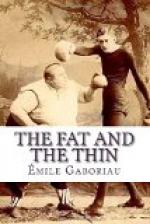beleaguering Paris, and two millions of people were
shut off from the world, I often strolled to the Halles
to view their strangely altered aspect. The fish
pavilion, of which M. Zola has so much to say, was
bare and deserted. The railway drays, laden with
the comestible treasures of the ocean, no longer thundered
through the covered ways. At the most one found
an auction going on in one or another corner, and a
few Seine eels or gudgeons fetching wellnigh their
weight in gold. Then, in the butter and cheese
pavilions, one could only procure some nauseous melted
fat, while in the meat department horse and mule and
donkey took the place of beef and veal and mutton.
Mule and donkey were very scarce, and commanded high
prices, but both were of better flavour than horse;
mule, indeed, being quite a delicacy. I also
well remember a stall at which dog was sold, and,
hunger knowing no law, I once purchased, cooked, and
ate a couple of canine cutlets which cost me two francs
apiece. The flesh was pinky and very tender,
yet I would not willingly make such a repast again.
However, peace and plenty at last came round once more,
the Halles regained their old-time aspect, and in the
years which followed I more than once saw the dawn
rise slowly over the mounds of cabbages, carrots,
leeks, and pumpkins, even as M. Zola describes in the
following pages. He has, I think, depicted with
remarkable accuracy and artistic skill the many varying
effects of colour that are produced as the climbing
sun casts its early beams on the giant larder and its
masses of food—effects of colour which,
to quote a famous saying of the first Napoleon, show
that “the markets of Paris are the Louvre of
the people” in more senses than one.
The reader will bear in mind that the period dealt
with by the author in this work is that of 1857-60,
when the new Halles Centrales were yet young, and
indeed not altogether complete. Still, although
many old landmarks have long since been swept away,
the picture of life in all essential particulars remained
the same. Prior to 1860 the limits of Paris were
the so-called boulevards exterieurs, from which
a girdle of suburbs, such as Montmartre, Belleville,
Passy, and Montrouge, extended to the fortifications;
and the population of the city was then only 1,400,000
souls. Some of the figures which will be found
scattered through M. Zola’s work must therefore
be taken as applying entirely to the past.
Nowadays the amount of business transacted at the
Halles has very largely increased, in spite of the
multiplication of district markets. Paris seems
to have an insatiable appetite, though, on the other
hand, its cuisine is fast becoming all simplicity.
To my thinking, few more remarkable changes have come
over the Parisians of recent years than this change
of diet. One by one great restaurants, formerly
renowned for particular dishes and special wines,
have been compelled through lack of custom to close
their doors; and this has not been caused so much by
inability to defray the cost of high feeding as by
inability to indulge in it with impunity in a physical
sense. In fact, Paris has become a city of impaired
digestions, which nowadays seek the simplicity without
the heaviness of the old English cuisine; and, should
things continue in their present course, I fancy that
Parisians anxious for high feeding will ultimately
have to cross over to our side of the Channel.




